Creative Education, 2018, 9, 2627-2646
http://www.scirp.org/journal/ce
ISSN Online: 2151-4771
ISSN Print: 2151-4755
Education for Sustainability Curriculum and
Pedagogy in Higher Education Institution:
Using Complex Adaptive System as a
Framework
Siti Nur Diyana Mahmud1, Zaizul Abdul Rahman2
1Faculty of Education, Universiti Kebangsaan Malaysia, Bangi, Malaysia
2Faculty of Islamic Studies, Universiti Kebangsaan Malaysia, Bangi, Malaysia
How to cite this paper: Mahmud, S. N. D.,
& Rahman, Z. A. (2018). Education for
Sustainability Curriculum and Pedagogy in
Higher Education Institution: Using Com-
plex Adaptive System as a Framework.
Creative Education, 9, 2627-2646.
https://doi.org/10.4236/ce.2018.915198
Received: October 13, 2018
Accepted: November 23, 2018
Published: November 26, 2018
Copyright © 2018 by authors and
Scientific Research Publishing Inc.
This work is licensed under the Creative
Commons Attribution International
License (CC BY 4.0).
http://creativecommons.org/licenses/by/4.0/
Open Access
Abstract
This paper presents the study on the interaction between Education for Sus-
tainability (EfS) curriculum and pedagogy with EfS systems structure. Com-
plex Adaptive System (CAS) was used as a framework in analysing the data.
This study identified the EfS curriculum and pedagogy has being stimulated
by socio-cultural factors, local sustainability issues and global sustainability
agenda.
Keywords
Systems Thinking, Education for Sustainable Development, Higher
Education, Curriculum, Pedagogy
1. Introduction
In 2002, the United Nations (UN) declared the period 2005-2014 as the Decade
of Education for Sustainable Development (DESD). Education for Sustainable
Development or Education for Sustainability (EfS) is a process that develops
people’s awareness, competence, attitudes and values, enabling them to be effec-
tively involved in sustainable development at local, national and international
levels, and helping them to work towards a more equitable and sustainable fu-
ture. In particular, it enables people to integrate social and cultural considera-
tions with environmental and economic decision-making (Huckle & Sterling,
1996). The aims of Education for Sustainable Development (ESD) suggested by
UNESCO are to help people to “develop the attitudes, skills, and knowledge to
DOI: 10.4236/ce.2018.915198 Nov. 26, 2018
2627
Creative Education
�
S. N. D. Mahmud, Z. A. Rahman
DOI: 10.4236/ce.2018.915198
make informed decisions for the benefit of themselves and others, now and in
the future, and to act upon these decisions” (UNESCO, 2017: p. 13). Other stu-
dies (Rowe, 2002; Sterling & Thomas, 2006; Sipos, Battisti, & Grimm, 2008; Se-
galàs, Ferrer-Balas, Svanström, Lundqvist, & Mulder, 2009; Wiek, Withycombe,
& Redman, 2011) have suggested that Education for Sustainability (EfS) goals
are to generate students’ competence in systemic thinking, critical thinking, able
to work within trans-disciplinary field, and to cultivate values that are consistent
with sustainability paradigms. Despite these lofty aspirations and more than 30
years of the official introduction of the term sustainable development in the
Brundtland Report (1987), the impact of EfS is unclear and inconclusive. This
raises important questions that warrant exploration. Is higher education guilty of
ineffectively doing the same thing over and over again? And is it time to step
back and reflect on the efficacy of EfS strategies to make sure they are producing
the intended results?
In this paper, the finding from the study in one Malaysian case university will
be presented. Since the concept of sustainability was raised in Agenda 21, the
Malaysian government has promoted holistic development. Malaysia began to
implement proactive policies and strategies at different levels from the 7th Ma-
laysia Plan (Malaysia, 1996) onwards. More than 60 years ago since indepen-
dence, Malaysia has undergone rapid economic growth. While the development
of nation over the last six decades is impressive, the rapid pace of change has
shown its’ detrimental effects on the natural environment. In this paper, the next
sections will present the current Education for Sustainability in Malaysian Case
University, the theoretical framework Complex Adaptive System, the metho-
dology, and findings and discussion.
2. Education for Sustainability in Malaysian Case University
While sustainability has become a ‘buzzword’ in Malaysian higher education in-
stitutions there are no comprehensive studies that investigate the interaction
between EfS curriculum and pedagogy with EfS system structures. Previous stu-
dies of sustainability in Malaysian HEIs focused on separated dimensions of
sustainability in HEI (e.g. Darus et al., 2009; Derahim, Hashim, Ali, & Derahim,
2011; Abdulrazak & Ahmad, 2014; Omar et al., 2009) rather than on multiple
and integrated dimensions. To understand the EfS enactment in this study, it
requires more than simply an examination of the EfS curriculum and pedagogy.
To grasp why and how the EfS is implemented by the participants, the study
needs to consider the contexts and the structure of the system in which it was
created and implemented (Lattuca & Stark, 2009). In line with this, Bateson
(1987) argued that learning is about the relationship between humans or the or-
ganisations and their biophysical environment.
Systems structure is the next level of explanation, which reveals how trends
and patterns relate to and affect one another. This represents a much deeper lev-
el of thinking that can demonstrate how the interaction between various factors
2628
Creative Education
�
S. N. D. Mahmud, Z. A. Rahman
gives rise to the observable outcomes. The uptake and implementation of EfS in
the HEI curriculum is slow, due to barriers such as lecturer understanding and
attitude (Dawe, Jucker, & Martin, 2005), the discipline-focused nature of many
academics’ work (Moore, 2005), the perceived irrelevance of EfS to some discip-
lines, and crowded existing curricula (Dawe, Jucker, & Martin, 2005). To under-
stand the interaction and patterns at the systems structure level, CAS was ap-
plied as the framework for the analytic process. A detailed explanation of how
CAS is being used as a framework in this study will be discussed in the next sec-
tion.
Data from three established high-ranking public research universities in
Malaysia indicated that university sustainability programs focus mainly on
physical campus greening, green procurement and research on green technol-
ogy (Omar et al., 2009). This mirrors findings from England where the stra-
tegic review of EfS by the Higher Education Funding Council for England
(2008) identified, HEIs focused on campus greening rather than substantive
reform of pedagogy and curriculum. According to Sydow (2012), sustainability
in higher education typically refers to greening the campus and attempts to
reduce the university’s ecological footprint. A study by Elfithri et al. (2017) on
a decade of sustainable campus programmes in the Malaysian case University
found that the programmes are not properly planned or coordinated. Many
programs are condensed into a short period of time. Elfithri et al. (2017) also
found that there are unequal activities among sustainable research groups with
only one of the three groups (i.e. Sustainable Ecosystem Management Research
Group) still active. The Sustainable Ecosystem Management Research Group
focuses on conservation and management of water, energy, and waste re-
sources. Unfortunately, EfS is not a priority for even this active research group
so the achievement of the sustainable development goals (UNESCO, 2017)
seems even more remote. Despite 10 years of sustainability initiatives in the
Malaysian case University, Derahim et al.’s (2011) and Er Ah Choi et al. (2017)
identified critical gaps and weaknesses remained in the knowledge and aware-
ness of students and staff which poses major challenges to Malaysian case
University.
Education for sustainability literature argues that to implement EfS, requires a
change of fundamental epistemology in educational thinking, practice and cul-
ture (Bacon et al., 2011; Barth, 2013; Pappas, 2012; Sterling, 2004). The present
study took up the clear requirement for a systems approach that addresses the
interconnection between dimensions of the problem and provides an integrated
way of seeing and thinking about the problem. In this case, the systems approach
entails documenting the interconnection between the organisational structures
and policies of the Malaysian case University; as well as relevant aspects of the
social and political context in Malaysia more generally. Such an analysis is de-
signed to provide an understanding of the wicked educational problem where
EfS does not produce the intended result.
2629
Creative Education
DOI: 10.4236/ce.2018.915198
�
S. N. D. Mahmud, Z. A. Rahman
DOI: 10.4236/ce.2018.915198
3. Complex Adaptive Systems
A CAS is being utilised as the analytical framework to understand the interac-
tion of EfS curriculum and pedagogy, with EfS systems structure levels. Many
natural systems (e.g., immune systems, ecologies, societies) are characterized by
complex behaviours that emerge as a result of often nonlinear interactions
among a large number of component systems at different levels of organisation.
These systems, which are dynamic systems with the ability to adapt in and
evolve with a changing environment, have recently become known as Complex
Adaptive System (CAS). It is important to be aware that there is no separation
between a system and its environment because all systems exist within their own
environment and they are also part of that environment. When the system
changes, it changes its environment, and as the environment changes, the system
needs to change again. Within such a context, change needs to be seen in terms
of co-evolution with all other related systems, rather than as adaptation to a sep-
arate and distinct environment. According to CAS theory, the environment and
the system co-evolve (Holland, 1992); changes in the system change the envi-
ronment, which requires the system to change again to fit with the new changed
environment.
In the CAS framework, sensitivity to the external environment reflects the
idea that organisms and their environments evolve together. Sensitivity to ex-
ternal events and the flexibility to adapt in a timely manner are key success fac-
tors for organisations seeking to improve sustainability under such conditions
(Holland, 1992; Karwowski, 2012). The process of interaction between a system
and its environment involves selection and temporality: selection, because the
system has to recognise which phenomena, out of a range, are to be responded
to; and temporality, because a process of change takes time.
4. Methodology
The systems theory approach to understanding sustainability in policy and prac-
tice requires intensive description and insight into a specific context. The intent
of this study is to describe and analyse the systemic patterns that emerge at the
Malaysian case university EfS system structures, and EfS curriculum and peda-
gogy interact. Such a purpose suggests a case study design since, according to
Yin (2003) it is the recommended approach when: 1) the focus of the study is to
answer “how” and “why” questions; 2) the behaviour and interpretations of
those involved in the study cannot be manipulated; and 3) the contextual condi-
tions are relevant to the phenomenon under study. For these reasons, the case
study design was chosen as the research design. The choice of the University was
based on accessibility for the researcher but also it was a “telling case” since it
has a particular mission in Malaysia as the University concerned with national
culture and heritage. So understanding the sustainability policies and practices
in this context has potential to reveal what a distinctive and nuanced Malaysian
approach to EfS might entail.
2630
Creative Education
�
S. N. D. Mahmud, Z. A. Rahman
The data used in this paper were from the series of interviews with lecturers
who teach sustainability related courses (i.e.: L1, L2, L3, L4, L5, and L6). All the
lecturer participants are female lecturers from diverse fields (i.e. anthropology,
education, applied biology, engineering, and general study). Meanwhile, focus
group interviews were conducted with three groups of students (Focus group 1,
2, and 3) enrolled in the selected sustainability courses (Course 1, 2, and 3). The
participants in the three focus groups were volunteers from each course. The
data also consist of analysis of the course structure form selected sustainability
courses, observation in the three sustainability courses and analysis of docu-
ments. The characteristic of the participants in the focus group 1, 2, and 3 is
shown in Table 1.
Meanwhile, for the observation in sustainability related courses teach by L2
(teach Course 1), L1 (teach Course 2) and L4 (teach Course 3), the criteria that
been observed are; a). Content covered during the lesson, b). Types of activities
implemented during the lesson, c) Role of the lecturer during the lesson, d). Role
of the student during the lesson, and e). Interaction between the lecturer and
students. For focus group interviews with the students enrolled in the Course 1,
2, and 3, the questions concerning EfS learning and teaching were following the
dynamic flow of topic communicated during the focus group interviews. The
questions were not strictly structured for focus group interviews. The data in this
study were analysed through thematic analysis.
5. Findings
This paper will present and discuss the findings of the interaction between EfS
systems structure, and EfS curriculum and pedagogies. Perceived EfS curriculum
and pedagogies data were derived from the interviews with the lecturers, student
participants’ focus group interviews, class observations, and course structure
documents. EfS systems structure was identified from lecturer’s interviews, stu-
dent participants’ focus group interviews, class observations, course structure
documents, the university mission statement, the university sustainable campus
mission and objective statements, the university sustainable charter, reports
available on sustainability programmes at the university from 2008-2017, sus-
tainability research projects documented by the University Centre for Research
and Instrumentation, the university sustainability-related Credited Co-curricular
Activities, sustainability competency courses and elective courses offered to the
students at the Malaysian case University, and Green Metric World University
Sustainability Ranking 2014-2107 audit reports.
In this paper, the discussion of the interaction between EfS systems structure
and EfS curriculum and pedagogies are divided into five sections: 1) so-
cio-cultural influence on EfS learning and teaching, 2) religion interaction on
EfS learning and teaching, 3) local sustainability issues influence on EfS teach-
ing, 4) global influence on EfS teaching; and 5) educator’s factors influence on
EfS teaching.
2631
Creative Education
DOI: 10.4236/ce.2018.915198
�
S. N. D. Mahmud, Z. A. Rahman
DOI: 10.4236/ce.2018.915198
Table 1. Focus group description.
Focus group
Description
Focus group 1
Focus group 2
Focus group 3
Focus group 1 consists of six students. Participants were Malay and
Female Muslim students. This group is a mix of students from
Anthropology, Development Sciences and Geography programs.
Focus group 2 consists of five students. This group of participants
was a mix of genders, races, religions and discipline background.
The discipline background ranged from science and technology,
engineering, law and social sciences.
Focus group 3 consists of five students. Participants in this group
were Malay and Muslim and came from Biology program. This
group had a mix of genders.
5.1. Socio-Cultural Influence on EfS Learning and Teaching
Many voices, including UNESCO, the World Summit on Sustainable Develop-
ment, and researchers, are calling for the inclusion of socio-cultural considera-
tions into the sustainable development model (UCLG, 2011). The socio-cultural
issues can shape what people mean by development and determine how people
act in the world. In this section, the findings of socio-cultural influence on EfS
learning and teaching are presented and discussed.
In Malaysia context, the power distant dimension is very high (Hofstede In-
sight, 2017). Power distance is a term that describes how people view power rela-
tionships of superior and subordinate relationships between people. Individuals
in cultures demonstrating a high power distance are very deferential to figures of
authority and generally accept an unequal distribution of power. The high power
distance was also reflected in learning and teaching in this study. According to
Hofstede (1986), power distance has a strong impact on learning in the context
of a student-lecturer relationship. This leads to passive learning, where the stu-
dents are hesitant about being critical towards what the lecturer said, and asking
questions in a class. L1, during her interview, raised her concern about passive
culture adopted by the Malaysian students in her class. She stated:
I will deliver a lecture to teach about “sustainability”. Nevertheless, it is diffi-
cult to encourage the students to ask questions during the lecture. I think you
are familiar with the students’ culture in Malaysia. To overcome the problem, I
pose a question to give them an issue, so they have to give their own opinion
(L1’s interview).
L1’s concern about her students’ participation during the class had driven her
to move from a traditional lecture to a more participatory learning. Her ap-
proach is that she is still guiding the discussion with students instead of opening
a discussion which is fully led by the students. Her approach in teaching could
be observed during Course 2 class observation. L1’s view on EfS purpose interac-
tion with EfS curriculum and pedagogies in a context where “face-saving” cul-
ture is dominant, the students usually avoid asking questions until they fully
understand the whole lesson to prevent being seen as unintelligent (Hoffstaedter,
2632
Creative Education
�
S. N. D. Mahmud, Z. A. Rahman
2011). In the same vein, L3 argued that her students prefer to ask questions
one-to-one after the class rather than during the class. She stated, “If they have
any question, usually they will come to ask the lecturer after the class dismissed.
Nevertheless, they always said they understand the lesson during class (laugh)”
(L3’s interview). Furthermore, in a face-saving culture, they tend to be less criti-
cal towards the teacher, to show their respect to the teacher (Hoffstaedter, 2011).
In addition, L4 also noted the passiveness of the students in her class. She stated,
“I need to probe them with a lot of questions to encourage them to speak in a
class. Otherwise, they will be silent. It is difficult to identify whether they under-
stand the lesson or not” (L4’s interview). The passiveness of the students also
appeared during the class observations. During class observation in Courses 1, 2,
and 3, it was noticed the students were busy taking down their lecture notes. It
appeared that the students were passively absorbing information presented by
the lecturers, despite research indicated that didactic, teacher-centered education
results in reduced cognitive and behavioural outcomes (Segalàs, et al., 2009;
Redman, 2013). Nevertheless, in a collectivist cultural context, this type of beha-
viour from the students is considered as appropriate and a norm when they are
in the classroom. The lecturers in many Asian cultures are given the status of
guru, who are responsible to learners in their search for knowledge and who are
perceived by the students as the primary source of knowledge in the classroom
(Sulaiman, 2013). The stream of knowledge is transmitted in a one-way direc-
tion from lecturers to students. This finding is consistent with the study con-
ducted by Yen et al. (2005) that reported a great number of Malaysian students
are passive and spoon-fed learners, who rely heavily on rote learning. Neverthe-
less, despite the students’ noticeable passiveness in the class, the student partici-
pants actually preferred active learning modes that emphasize hands-on and
outdoor learning as they stated during focus group interviews. While the stu-
dents act passively and adhere to the local cultural norms for compliance, they
prefer learning actively in the field instead of didactic learning in the classroom.
“Collectivism” is another important socio-cultural feature. In collectivist so-
cieties, conflict is avoided as it is important to form mutual opinions with other
members of the society. In this study, L3 was aware of the reason that her stu-
dents were not expressing their individual opinions when they were doing the
case study in a group. The written report completed by the students merely in-
cluded factual information. Thus, she asked them to write their individual ref-
lections. She stated:
We also embed the concept of environment in the learning process. For ex-
ample, by giving students tasks based on places or place-based or evaluation on
the surrounding area. I will ask the students to do the case study and report in a
group, but they need to write an individual reflection of what they have learnt
from the case study. Sometimes, they just write the factual information in the
report without critically discussing. It is difficult to ‘hear their voice’ in the re-
port. Thus, I asked them to write an individual reflection. They can write how
2633
Creative Education
DOI: 10.4236/ce.2018.915198
�
S. N. D. Mahmud, Z. A. Rahman
DOI: 10.4236/ce.2018.915198
they feel, and what they think in the reflection (L3’s interview).
Based on L3’s excerpt, it showed that she deliberately adopted various ways to
counter what she perceived as a sociocultural impediment to deeper under-
standing. She focused on the individual understanding through reflective writing
about feelings and thoughts. Individual understanding is not the most important
in collectivism. Nevertheless, the mutual consensus is more appreciated. There-
fore, L3’s strategy is to work across this dilemma.
L2 also commented on the socio-cultural influence on the sustainable beha-
viour and EfS learning. The notion of collectivism in her interview concerned of
how the society and students value belonging to a group. She stated:
Social value has some impacts. In Malaysia nowadays, the values from social
surrounding are slowly gaining some impacts on human behaviour towards the
environment. They started considering the community pressure towards pro-
tecting the environment. Especially in urban areas, the socio-culture started to
transform towards more environmental friendly. The similar situation is slowly
gaining popularity in the university campus. Don’t be surprised if the students
said they do environmental friendly behaviour not for the sake of taking care the
environment, but for their social image, and follow their peers’ actions. Thus,
when we are planning educational programs for EfS, we need to consider on
how to make the program popular and interesting for the students (L2’s inter-
view).
L2’s reflection contrasts an authentic commitment to the environment with
the spread and uptake of social norms regarding littering and other environ-
mental behaviours. She suggested that the shift of the students towards more re-
sponsible behaviours and interest in sustainability is related to group conformity
and popularity. Thus, she suggested EfS programs should be able to attract the
students by making it more exciting. When many students are attracted to in-
volve in EfS programs, it will create social norms at the university and more
students will join the programs in the future.
L4 argued that her students are strategic institutional learners as they are like-
ly to carry out the activity only if it has marks for their course. L4 noted:
It is hard to find volunteers to do sustainability works. The culture here is,
everything needs to be enforced, through a top-down management instruction.
Same situation with the students. You need to give marks or credit, or make it
compulsory, for every task you asked them to do. Otherwise, it is difficult to find
students who volunteer to do it (L4’s interview).
In highly collective societies, a reward obtained at the end of the program is
highly appreciated (Hofstede Insight, 2017). Thus, it is predictable when L4 ob-
served that her students were reluctant to participate in EfS activity if there was
no reward offered to them at the end of the activity. In addition, based on the
analysis of sustainability programs at the university, an eco-volunteer activity
which started in 2011, became a credited co-curricular activity in 2015. As a re-
sult, more students began to participate in such activity.
2634
Creative Education
�
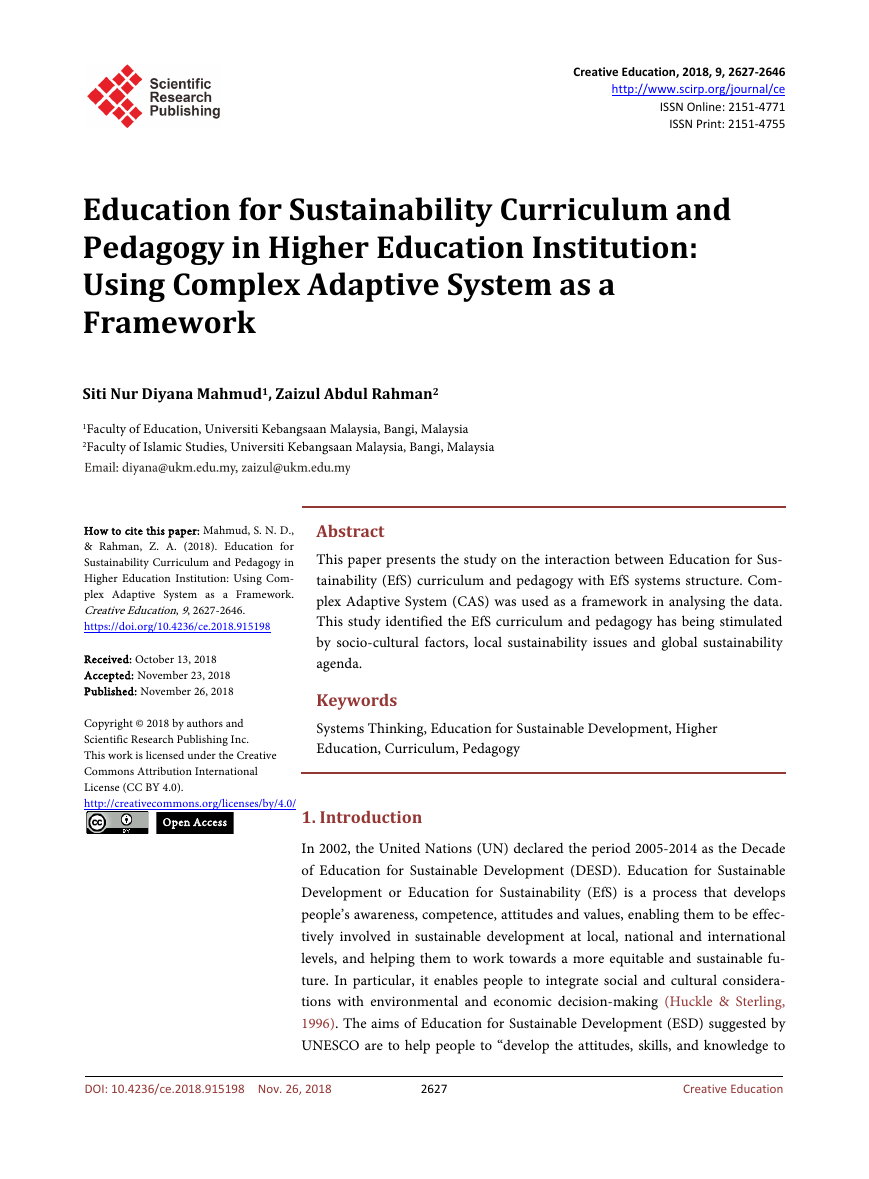
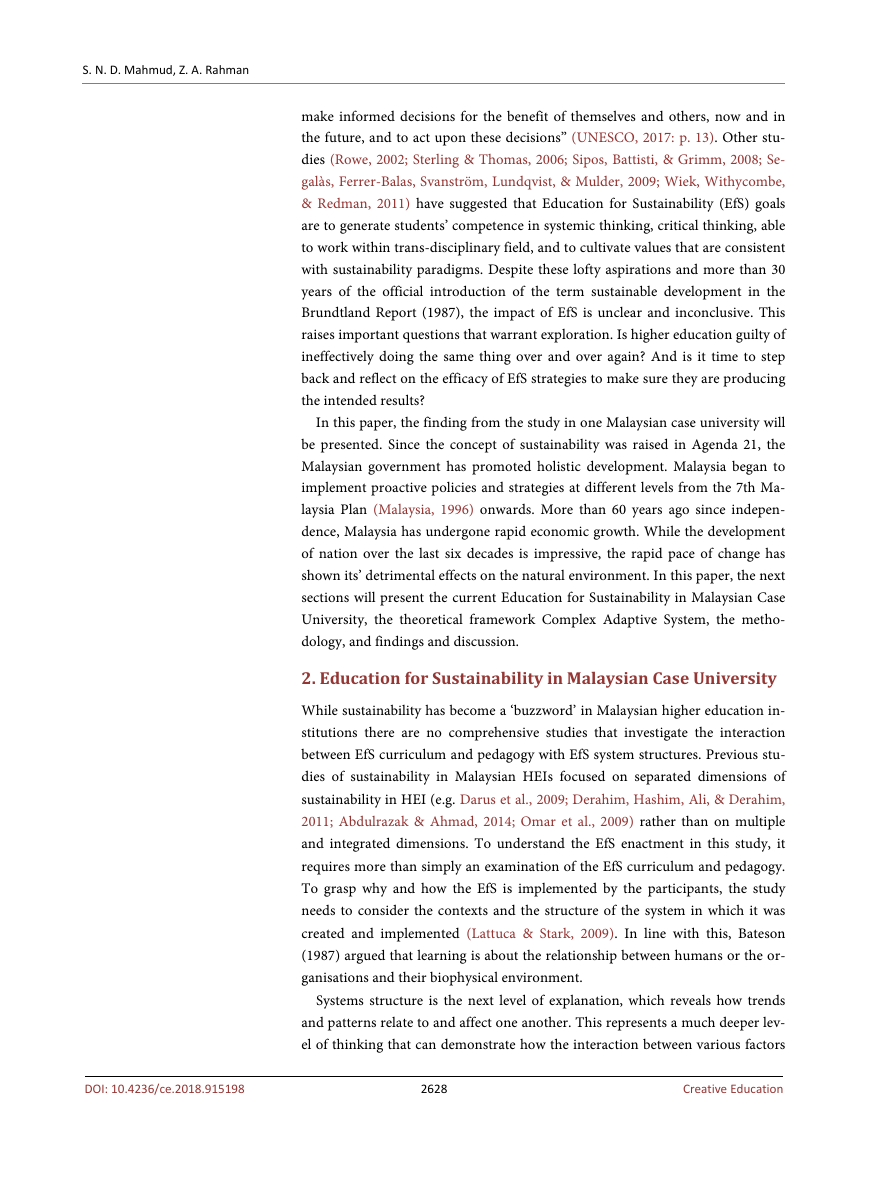

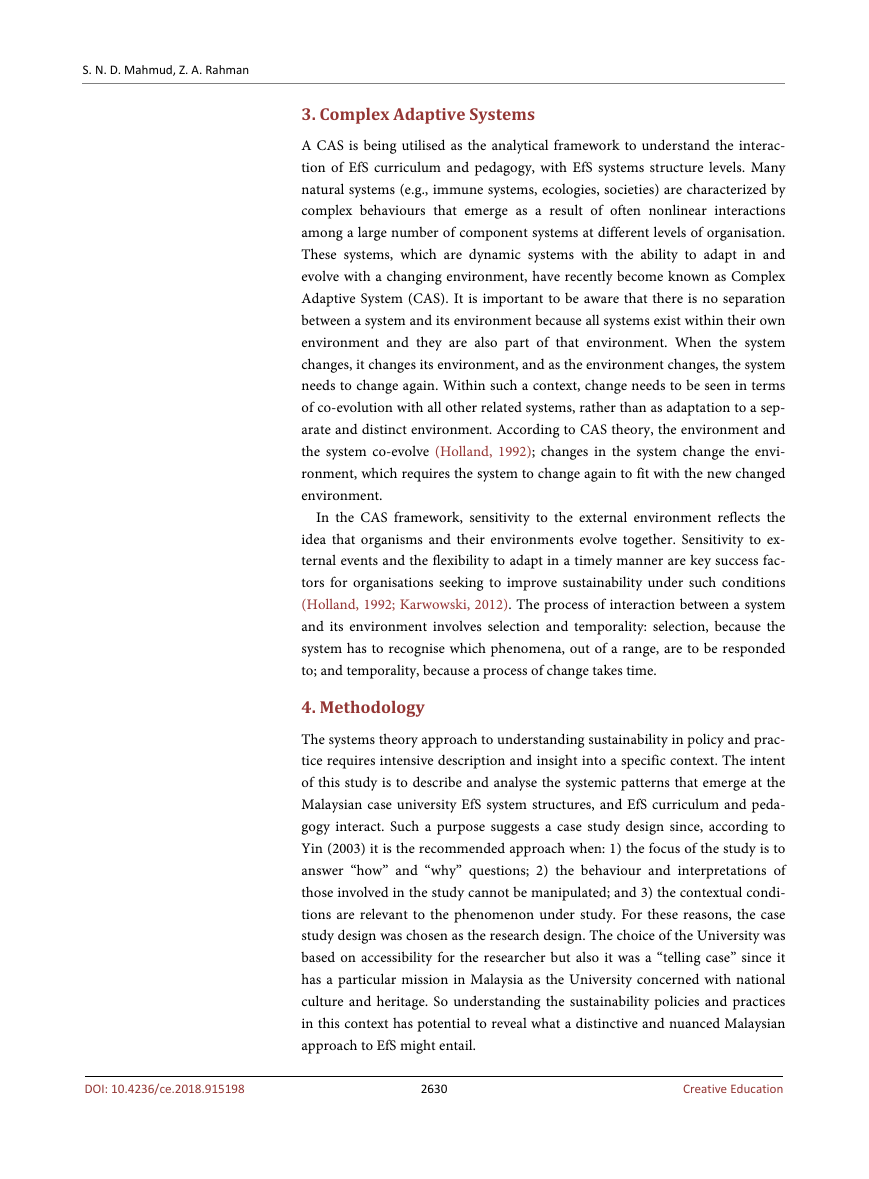
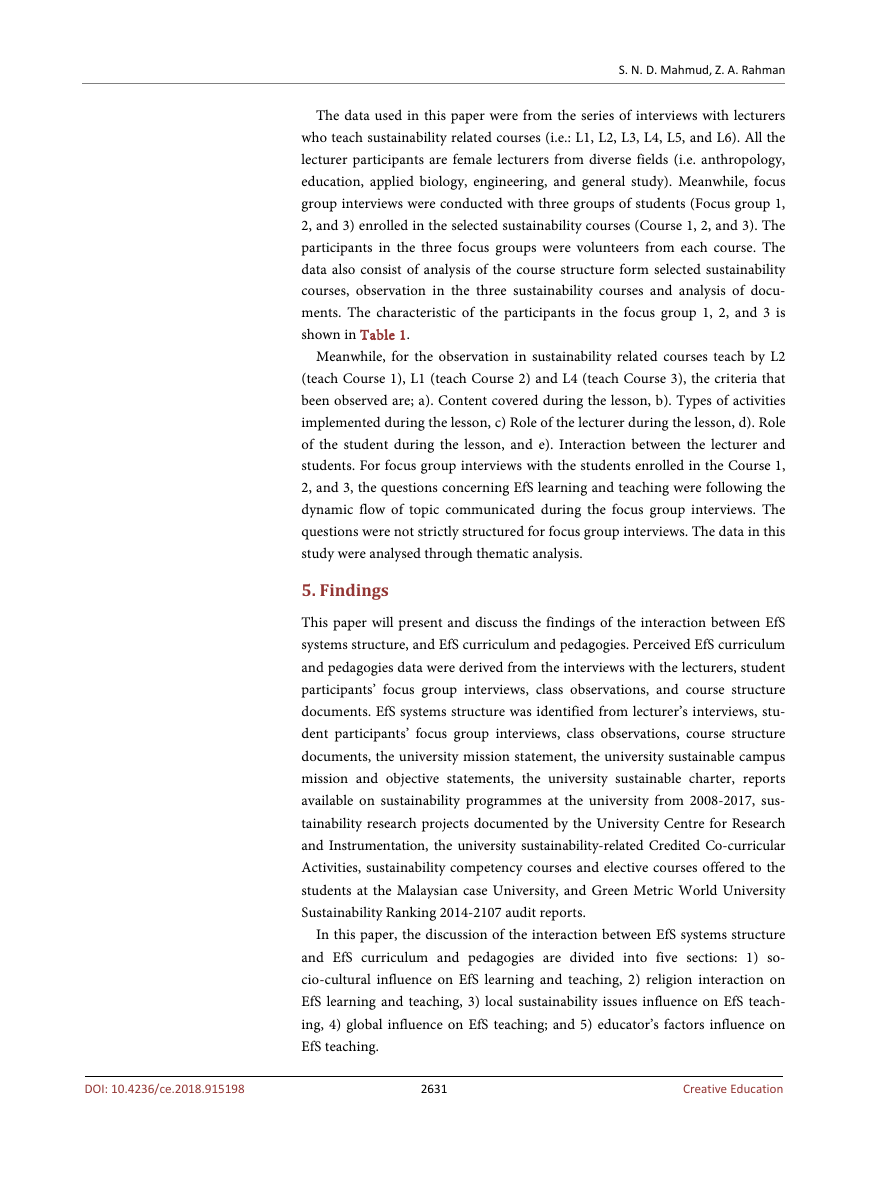

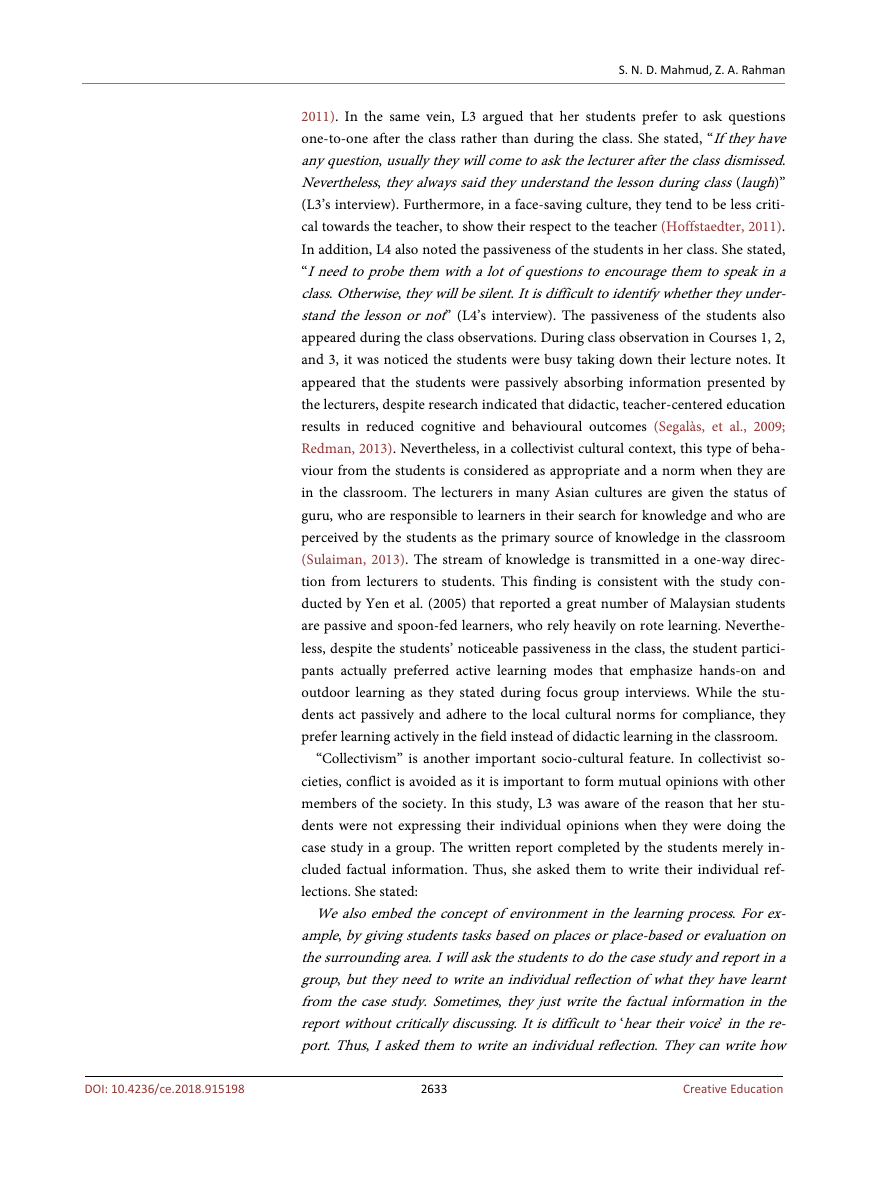
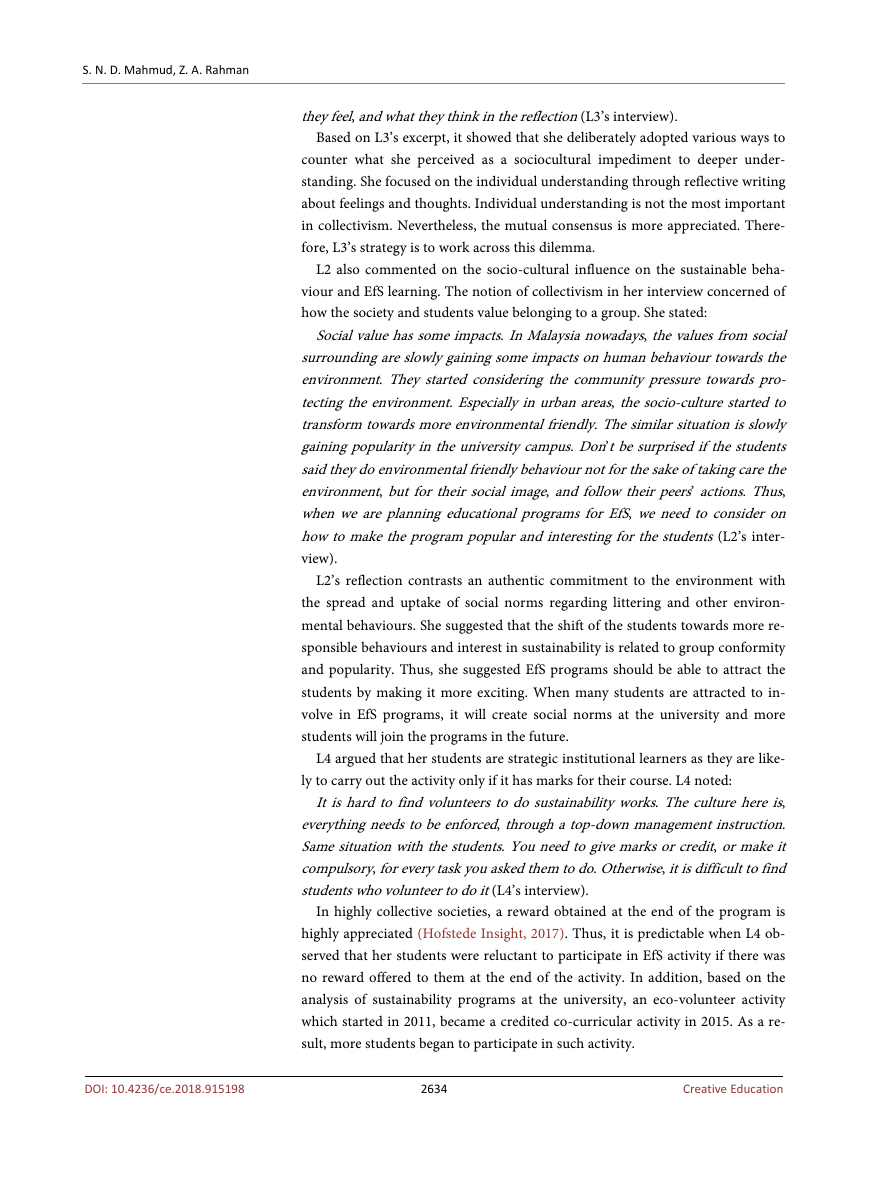








 2023年江西萍乡中考道德与法治真题及答案.doc
2023年江西萍乡中考道德与法治真题及答案.doc 2012年重庆南川中考生物真题及答案.doc
2012年重庆南川中考生物真题及答案.doc 2013年江西师范大学地理学综合及文艺理论基础考研真题.doc
2013年江西师范大学地理学综合及文艺理论基础考研真题.doc 2020年四川甘孜小升初语文真题及答案I卷.doc
2020年四川甘孜小升初语文真题及答案I卷.doc 2020年注册岩土工程师专业基础考试真题及答案.doc
2020年注册岩土工程师专业基础考试真题及答案.doc 2023-2024学年福建省厦门市九年级上学期数学月考试题及答案.doc
2023-2024学年福建省厦门市九年级上学期数学月考试题及答案.doc 2021-2022学年辽宁省沈阳市大东区九年级上学期语文期末试题及答案.doc
2021-2022学年辽宁省沈阳市大东区九年级上学期语文期末试题及答案.doc 2022-2023学年北京东城区初三第一学期物理期末试卷及答案.doc
2022-2023学年北京东城区初三第一学期物理期末试卷及答案.doc 2018上半年江西教师资格初中地理学科知识与教学能力真题及答案.doc
2018上半年江西教师资格初中地理学科知识与教学能力真题及答案.doc 2012年河北国家公务员申论考试真题及答案-省级.doc
2012年河北国家公务员申论考试真题及答案-省级.doc 2020-2021学年江苏省扬州市江都区邵樊片九年级上学期数学第一次质量检测试题及答案.doc
2020-2021学年江苏省扬州市江都区邵樊片九年级上学期数学第一次质量检测试题及答案.doc 2022下半年黑龙江教师资格证中学综合素质真题及答案.doc
2022下半年黑龙江教师资格证中学综合素质真题及答案.doc